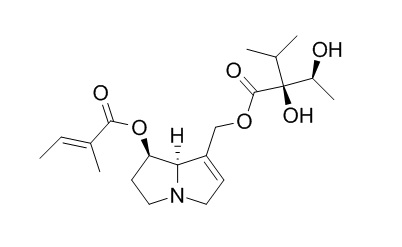Symlandine
Symlandine, 7-acetylintermedine, and 7-acetyllycopsamine are pyrrolizidine alkaloids, isolated from comfrey, can produce hepatotoxicity in livestock and humans and carcinogenicity in experimental animals.
Inquire / Order:
manager@chemfaces.com
Technical Inquiries:
service@chemfaces.com
Tel:
+86-27-84237783
Fax:
+86-27-84254680
Address:
1 Building, No. 83, CheCheng Rd., Wuhan Economic and Technological Development Zone, Wuhan, Hubei 430056, PRC
Providing storage is as stated on the product vial and the vial is kept tightly sealed, the product can be stored for up to
24 months(2-8C).
Wherever possible, you should prepare and use solutions on the same day. However, if you need to make up stock solutions in advance, we recommend that you store the solution as aliquots in tightly sealed vials at -20C. Generally, these will be useable for up to two weeks. Before use, and prior to opening the vial we recommend that you allow your product to equilibrate to room temperature for at least 1 hour.
Need more advice on solubility, usage and handling? Please email to: service@chemfaces.com
The packaging of the product may have turned upside down during transportation, resulting in the natural compounds adhering to the neck or cap of the vial. take the vial out of its packaging and gently shake to let the compounds fall to the bottom of the vial. for liquid products, centrifuge at 200-500 RPM to gather the liquid at the bottom of the vial. try to avoid loss or contamination during handling.
J. Food Composition and Anal.2022, V 109:104482.
Sci Rep.2025, 15(1):29590.
Nat Commun.2024, 15(1):8221.
LWT2024, 200:116184.
Molecules.2024, 29(5):1050.
Anticancer Res.2018, 38(4):2127-2135
PLoS One.2020, 15(2):e0220084.
Pharmacol Rep.2018, 70(6):1195-1201
Molecules.2021, 26(6):1635.
Int J Mol Sci.2019, 20(16):E4015
Related and Featured Products
J Toxicol Environ Health B Crit Rev. 2010 Oct;13(7-8):509-26.
Metabolism, genotoxicity, and carcinogenicity of comfrey.[Pubmed:
21170807]
Comfrey has been consumed by humans as a vegetable and a tea and used as an herbal medicine for more than 2000 years. Comfrey, however, produces hepatotoxicity in livestock and humans and carcinogenicity in experimental animals. Comfrey contains as many as 14 pyrrolizidine alkaloids (PA), including 7-acetylintermedine, 7-acetyllycopsamine, echimidine, intermedine, lasiocarpine, lycopsamine, myoscorpine, Symlandine, symphytine, and symviridine. The mechanisms underlying comfrey-induced genotoxicity and carcinogenicity are still not fully understood. The available evidence suggests that the active metabolites of PA in comfrey interact with DNA in liver endothelial cells and hepatocytes, resulting in DNA damage, mutation induction, and cancer development.
METHODS AND RESULTS:
Genotoxicities attributed to comfrey and riddelliine (a representative genotoxic PA and a proven rodent mutagen and carcinogen) are discussed in this review. Both of these compounds induced similar profiles of 6,7-dihydro-7-hydroxy-1-hydroxymethyl-5H-pyrrolizine (DHP)-derived DNA adducts and similar mutation spectra. Further, the two agents share common mechanisms of drug metabolism and carcinogenesis.
CONCLUSIONS:
Overall, comfrey is mutagenic in liver, and PA contained in comfrey appear to be responsible for comfrey-induced toxicity and tumor induction.
J Nat Prod. 2001 Feb;64(2):251-3.
Isolation of symlandine from the roots of common comfrey (Symphytum officinale) using countercurrent chromatography.[Pubmed:
11430014]
METHODS AND RESULTS:
Three pyrrolizidine alkaloids, Symlandine, symphytine, and echimidine (1-3), were isolated from the roots of Symphytum officinale using a one-step countercurrent chromatography procedure. The structures of 1-3 were confirmed by several spectroscopic techniques including 2D NMR methods.
CONCLUSIONS:
This is the first description of the separation of Symlandine (1) from its stereoisomer, symphytine (2).



